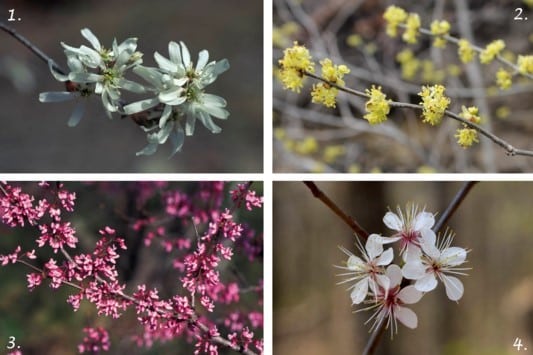
JEFFERSON CITY, Mo. – The Missouri Department of Conservation (MDC) encourages people to unwind in nature this spring by enjoying Missouri’s flowering trees and shrubs. Many of Missouri’s native trees and shrubs bloom in spring, putting on dazzling displays that attract native wildlife such as birds and pollinators. Flowering spring trees and shrubs can be enjoyed while out in the yard, out on a walk, or even from the indoors while social distancing.
Early-bloomers in the coming weeks include:
- Serviceberry with clusters of white flowers that appear before other native trees put on leaves, allowing this often-overlooked tree to stand out in wooded areas. When you spot a blooming serviceberry, take note of the location. You can return in early June to enjoy the serviceberry’s delicious, blueberry-like fruits. Learn more at mdc.mo.gov/discover-nature/field-guide/downy-serviceberry
- Spicebush is a small shrub that commonly grows in moist wooded areas and along streams. It produces petite clusters of pale yellow flowers in early spring. As the host plant of the beautiful spicebush swallowtail butterfly, this shrub makes an attractive, wildlife-friendly addition to home landscaping. Learn more at mdc.mo.gov/discover-nature/field-guide/spicebush
- Redbud is celebrated each spring for the vibrant pink-purple flowers encircling the trees’ leafless branches. Fun fact: Redbud flowers are more than eye candy. They’re edible and make a tasty and colorful addition to salads and desserts! Learn more at mdc.mo.gov/discover-nature/field-guide/eastern-redbud
- Wild plum produces clusters of delicate white flowers that are visited by several species of bees. This small, thicket-forming tree is common along roadsides, in old fields, and on the edge of woods. Wild plum is a valuable food source for wildlife, but people can also enjoy the small, edible plums that ripen in late summer. Learn more at mdc.mo.gov/discover-nature/field-guide/wild-plum
MDC encourages people to plant native trees and shrubs and replace non-native varieties such as the invasive Bradford or Cleveland Select ornamental pear trees. These invasive species are known to multiply quickly and crowd out native Missouri plants. Though it’s been a popular landscaping tree for decades, cultivated forms have spread aggressively throughout the state. Cultivated varieties of this plant for sale include Aristocrat, Autumn Blaze, Bradford, Capital, Chanticleer, New Bradford, and Redspire, among others. All are invasive and should not be planted. The public is encouraged to visit grownative.org for a list of vendors that sell Missouri native plant species.
Wherever the location in Missouri, take time to enjoy the natural beauty of spring-flowering trees and shrubs. Learn more about Missouri’s native trees and plants on the MDC website at https://mdc.mo.gov/trees-plants.















